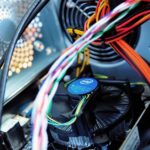
In today’s Computer Tip of the Day, we will talk about the differences between a newer generation solid state hard drive (SSD) and older-style hard drives, which are still installed in a vast majority of computers today. Every day, hundreds of thousands of computer hard drives will catastrophically fail, rendering your data dead and buried. Much like an automobile, computers are boxes made up of parts, some moving, some solid-state (not moving). These moving parts have a limited lifespan and will eventually seize up and completely fail, usually without notice.
Hard drive history
Basic hard drive technology is still in use today, primarily in desktop and laptop computers and even some MP3 players and video cameras. This technology is very similar to what it was in the late 1950’s and early 1960’s when the large computer corporations began to use them for data storage. The general function of a hard drive is the primary storage device of your computer. Typical hard drives spin at high speed (around 7200RPM) and read and write data to 1 or multiple fixed disk platters magnetically.
The problem with this technology is a high failure rate, typically within 2-4 years. This virtually means your data will completely be lost if you haven’t backed up. Secondly, the response time of the computer suffers due to this slower mechanism. Computers with older hard drives sometimes take up to 3 minutes to boot, while some computers running an SSD can boot in 30-45 seconds on average.
Enter the solid state hard drive
Advances in hard drive technology have brought us to the solid state hard drive. It still stores your computer’s data, but, in a mechanism with no moving parts. The best example of this technology is used in today’s tablet computers. Have you ever noticed how fast a tablet boots up and works in general? This is primarily because there is no hard drive to slow the device down. Instead, it uses high-speed storage chips which are basically a solid state hard drive in action. Fortunately, the prices of solid state hard drives have dropped dramatically in the last few years. They are now showing up in today’s computers.
Can I get one of these SSD’s in my computer?
Most computers that currently have older (and slower) hard drives can be upgraded to a much faster solid state hard drive. The speed boost when performing this upgrade can make older computers literally feel brand new. Also, sometimes increasing response and boot times exponentially. The average solid state hard drive upgrade has also become very affordable in the last few years. This is thanks to advances in technology and more widespread adoption. One of the things to think about with this upgrade is the size of the SSD you purchase. Keep in mind that a larger solid state hard drive will be much more expensive than the same-sized normal hard drive. Even though SSD prices have dropped, they are still not exactly on par with non-SSD prices.
For more information on this exciting new technology, please contact Bluwater Technologies today. We are always excited to talk to you about the benefits of upgrading and enhancing your personal or business computers with super-fast and affordable SSD drives.







No comment yet, add your voice below!